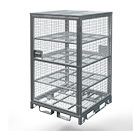Importance of Workplace Safety and How to Implement It?
Date Posted:15 August 2024
Workplace safety is an ongoing commitment that requires diligence, education, and a proactive approach. By prioritising the safety of your employees, you not only protect them from harm but also create a positive work environment that can lead to increase
In the dynamic and bustling work environments of Australia, from the skyscrapers of Sydney to the mines of Western Australia, workplace safety is more than a box-ticking exercise—it's a commitment to the well-being of every employee. Safety is the backbone of a productive, efficient, and happy workforce. This article delves into the importance of workplace safety and provides practical steps on how to implement effective safety measures in your business.
Why Workplace Safety Matters?
- Protecting Employees: The primary goal of workplace safety is to protect employees from injuries and illnesses. Every worker deserves to return home safe and sound at the end of the day. Implementing robust safety measures ensures their well-being and demonstrates that their safety is valued.
- Boosting Morale: A safe work environment boosts employee morale. When workers know that their employer prioritises their safety, they are more likely to feel valued and respected. This positive sentiment can lead to increased job satisfaction and loyalty.
- Enhancing Productivity: Safety and productivity go hand in hand. Fewer accidents mean less downtime and disruptions. When employees feel safe, they can focus on their tasks without worrying about potential hazards, leading to better performance and efficiency.
- Reducing Costs: Workplace accidents can be costly. Medical expenses, compensation claims, and the cost of replacing or retraining injured workers can add up. By investing in safety measures, businesses can avoid these expenses and save money in the long run.
- Compliance with Laws: In Australia, workplace health and safety (WHS) regulations are stringent. Non-compliance can result in hefty fines and legal repercussions. Adhering to safety standards ensures compliance with laws and helps avoid legal issues.
How to Implement Effective Workplace Safety Measures
- Conduct Risk Assessments: The first step in implementing safety measures is to identify potential hazards. Conduct thorough risk assessments to pinpoint areas of concern. Regularly review and update these assessments to keep up with any changes in the workplace environment.
- Develop a Safety Plan: Based on the risk assessments, develop a comprehensive safety plan. This plan should outline procedures for preventing accidents, emergency response protocols, and guidelines for safe work practices. Ensure that the plan is easily accessible to all employees.
- Provide Training and Education: Safety training is crucial for all employees. Regular training sessions ensure that everyone is aware of safety protocols and knows how to handle emergencies. Include specific training for new employees and refresher courses for existing staff.
- Promote a Safety Culture: Building a safety culture starts from the top. Management should lead by example and promote safety as a core value. Encourage employees to report hazards and near-misses without fear of reprisal. Reward and recognise safe behaviour to reinforce the importance of safety.
- Equip Employees with the Right Tools: Providing the right tools and equipment is essential for maintaining safety. This includes personal protective equipment (PPE) such as helmets, gloves, and high-visibility clothing, as well as specialised tools and machinery designed with safety features.
- Implement Regular Inspections and Maintenance: Regular inspections of equipment and machinery can prevent accidents caused by malfunctioning tools. Ensure that all equipment is properly maintained and that any issues are addressed promptly. Schedule regular safety audits to identify and rectify potential hazards.
- Emergency Preparedness: Being prepared for emergencies is a critical aspect of workplace safety. Develop and practice emergency response plans for various scenarios, including fires, chemical spills, and medical emergencies. Conduct regular drills to ensure that employees know how to respond swiftly and effectively.
- Encourage Open Communication: Foster an environment where employees feel comfortable discussing safety concerns. Regularly hold safety meetings and encourage feedback. Open communication can help identify potential issues before they become serious problems.
- Stay Updated with Regulations: WHS regulations can change, and it’s important to stay informed about any updates. Regularly review and update your safety policies to ensure compliance with the latest standards. Consider joining industry groups or subscribing to safety bulletins for the latest information.
Workplace safety is an ongoing commitment that requires diligence, education, and a proactive approach. By prioritising the safety of your employees, you not only protect them from harm but also create a positive work environment that can lead to increased productivity and reduced costs.
































































































































 Trolleys & Hand Trucks
Trolleys & Hand Trucks Cage Trolleys
Cage Trolleys Cleaning Carts & Trolleys
Cleaning Carts & Trolleys Construction Trolleys
Construction Trolleys Custom Trolleys
Custom Trolleys Hand Trucks & Dollies
Hand Trucks & Dollies Laundry/Linen Trolleys
Laundry/Linen Trolleys Lifting Trolleys
Lifting Trolleys Order Picking Trolleys
Order Picking Trolleys Panel Cart Trolleys
Panel Cart Trolleys Platform Trolleys
Platform Trolleys Powered Trolleys
Powered Trolleys Shelf & Tiered Trolleys
Shelf & Tiered Trolleys Shopping Trolleys
Shopping Trolleys Stainless Steel Trolleys
Stainless Steel Trolleys Tool Trolleys
Tool Trolleys Utility & Service Carts
Utility & Service Carts Lifting & Handling Equipment
Lifting & Handling Equipment Forklift Attachments
Forklift Attachments Jib Attachments
Jib Attachments Lifting Hoists & Pallet Hooks
Lifting Hoists & Pallet Hooks Load Skates & Tow Tugs
Load Skates & Tow Tugs Manual Stackers & Lifters
Manual Stackers & Lifters Pallet Jacks
Pallet Jacks Pallet Lifters
Pallet Lifters Pallet Rotators & Dispenser
Pallet Rotators & Dispenser Powered Pallet Trucks & Electric Lifters
Powered Pallet Trucks & Electric Lifters Scissor Lift Trolleys and Tables
Scissor Lift Trolleys and Tables Conveyor Equipment
Conveyor Equipment Conveyor Frames & Stands
Conveyor Frames & Stands Roller & Skate Conveyors
Roller & Skate Conveyors Ladders & Access Equipment
Ladders & Access Equipment Container & Yard Ramps
Container & Yard Ramps Ladders & Step Stools
Ladders & Step Stools Work Platforms & Crane Cages
Work Platforms & Crane Cages Drum Handling Equipment
Drum Handling Equipment Drum Storage & Bunding
Drum Storage & Bunding Drum Trolleys & Lifters
Drum Trolleys & Lifters Forklift Drum Handling
Forklift Drum Handling Waste Handling & Bins
Waste Handling & Bins Bin Lifters & Tippers
Bin Lifters & Tippers Plastic Waste & Wheelie Bins
Plastic Waste & Wheelie Bins Steel Waste & Tipping Bins
Steel Waste & Tipping Bins Waste Carts
Waste Carts Dangerous Goods Storage & Spillage
Dangerous Goods Storage & Spillage Aerosol Cans Storage Cages
Aerosol Cans Storage Cages Bunded Pallets & Storage
Bunded Pallets & Storage Corrosive Goods Storage Cabinets
Corrosive Goods Storage Cabinets DG Storage & Trolleys
DG Storage & Trolleys Flammable Liquid Cabinets
Flammable Liquid Cabinets Forklift Gas Storage Cages
Forklift Gas Storage Cages Site Storage
Site Storage Spill Kits
Spill Kits Shelving & Storage Equipment
Shelving & Storage Equipment Stillage & Transport Cages
Stillage & Transport Cages 750 Series Cage Configurations
750 Series Cage Configurations Heavy Duty Cabinets
Heavy Duty Cabinets Heavy Duty Shelving
Heavy Duty Shelving Mega Bins & Pallets
Mega Bins & Pallets Packing & Workbenches
Packing & Workbenches Parts Trays & Stor-Pak Bins
Parts Trays & Stor-Pak Bins Pegboard & Louvre Panels
Pegboard & Louvre Panels Plastic Bins & Crates
Plastic Bins & Crates Plastic Handling Solutions Bins
Plastic Handling Solutions Bins Plastic Pallets
Plastic Pallets Stack & Nest Bins
Stack & Nest Bins Pallet Racking Accessories
Pallet Racking Accessories Workplace Equipment
Workplace Equipment Modular Workbenches
Modular Workbenches Electric Height-Adjustable Workbenches
Electric Height-Adjustable Workbenches Floor Matting
Floor Matting General Workplace Equipment
General Workplace Equipment Industrial Weighing Scales
Industrial Weighing Scales Packaging Machinery
Packaging Machinery Stationery Cupboards
Stationery Cupboards Storage and Stillage Cages
Storage and Stillage Cages Tool Trolleys
Tool Trolleys Tooling Cabinets
Tooling Cabinets Workshop Fans and Coolers
Workshop Fans and Coolers Safety Barriers, PPE & Signage
Safety Barriers, PPE & Signage Barriers & Bollards
Barriers & Bollards First Aid Equipment
First Aid Equipment Gloves, Knives and PPE
Gloves, Knives and PPE Signage
Signage Cleaning & Site Supplies
Cleaning & Site Supplies Cleaning Equipment
Cleaning Equipment Cleaning Trolleys
Cleaning Trolleys Rubbish Bins
Rubbish Bins Signs & Traffic Supplies
Signs & Traffic Supplies Construction Equipment
Construction Equipment Construction Trolleys
Construction Trolleys Waste Handling
Waste Handling General Site Equipment
General Site Equipment Concrete Equipment
Concrete Equipment Site Storage
Site Storage Lifting Equipment
Lifting Equipment Verdex Specials
Verdex Specials Orange Stor-Pak Bins
Orange Stor-Pak Bins











